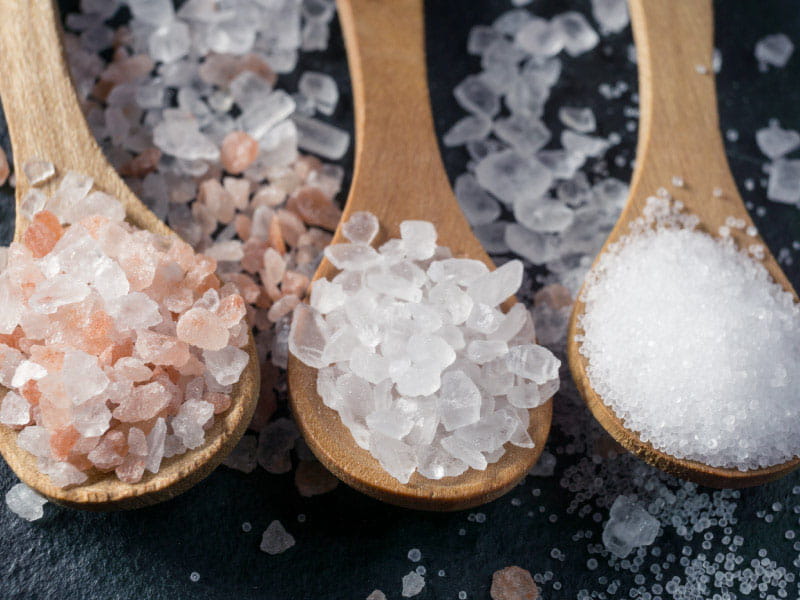Shake it or skip it? Here's expert advice on salt.
By Rachel Crowell, American Heart Association News

A sprinkle of sea salt, a smidgeon of table salt, a kiss of kosher salt: Seasoning with salt is often seen as vital to cooking. Salt also has been used to preserve food and even used as currency.
But it's the excess salt consumption that experts say poses a gigantic public health problem.
Table salt is made up of two minerals: sodium and chloride. Small amounts of sodium help the body control its fluids and play a role in nerve and muscle function. However, too much sodium in your diet can lead to high blood pressure, a major risk factor for cardiovascular disease.
"So, if we can reduce our blood pressure, that's going to save so many lives," said Dr. Tali Elfassy, a research assistant professor of epidemiology at the University of Miami Miller School of Medicine. Reducing "sodium is just one tool" for fighting high blood pressure, she noted.
Most adults should limit their daily sodium intake to a maximum of 2,300 milligrams, according to federal dietary guidelines. The ideal limit for most adults, especially those with high blood pressure, is 1,500 mg per day, the American Heart Association says.
Using different types of salt – table salt, kosher salt or sea salt – doesn't change those recommended limits. But the sodium amounts may differ based on the coarseness of the salt. "The coarser the salt and the bigger the crystals, the less actual amount fits on the spoon, and therefore the sodium level will be lower comparatively," said Michelle Routhenstein, a registered dietitian nutritionist who specializes in heart health at her private practice in New York.
Reducing salt intake to meet the recommended limits can seem daunting. But workarounds exist to help.
One big hurdle to overcome is the myth that reducing sodium intake means cooking flavorless food. Routhenstein said she encourages keeping the recommendations in perspective. "I have seen in my clients that people are looking for zero milligrams of sodium" when they read nutrition labels, she said. "You don't need a no-salt diet."
Think of the sodium recommendations as a daily salt budget. People often think 150 mg of sodium in a food item is too high, Routhenstein said. However, if you have high blood pressure and want to stay under the recommended 1,500 mg, "and you have three meals and two snacks, that can be divided as 350 milligrams per meal and 200 milligrams per snack," she said.
Routhenstein and Elfassy said putting down the saltshaker likely won't help with some of the biggest sources of sodium: packaged items and prepared foods, including those purchased from restaurants and fast-food chains. "There are some menu items that have 2,000 to 7,000 milligrams of sodium," Routhenstein said.
Finding information about sodium in restaurant food can require some sleuthing. It's unlikely to be listed, Elfassy noted.
According to the U.S. Food and Drug Administration, some chain restaurants are required to have nutrition information, including amounts of sodium, available upon request. This information is also often available online. However, the same information for restaurants not subject to this requirement, such as stand-alone local establishments, might be difficult to find.
Diners can ask for meals to be prepared with less salt. Eating smaller portions and saving half of the meal to eat the next day also reduces sodium intake when eating out.
When people frequently eat foods with a lot of salt, they often don't realize it, Routhenstein said. However, taste buds can change after switching to a low-salt eating pattern. "You then start realizing, 'Wow, that tastes overly salty to me,'" she said.
There are ways to add flavor to foods while relying less on salt. Experiment with different options and see what works best, Routhenstein said.
"Vinegars are a great way to cut back on salt and add a good amount of flavor," said Routhenstein, who uses a homemade sauce made from balsamic vinegar, sesame oil and ginger. "I use this as an umami soy sauce alternative to mimic teriyaki sauce without the high sodium level."
Spice lovers may gravitate toward low-sodium hot sauces or red pepper flakes. Food doesn't have to be ho-hum when "you can even go to the grocery store and buy salt-free mixes (such as) a 21-spice seasoning that's made with parsley, oregano, cumin, garlic and paprika," she noted. Lemon or lime juice can also make great alternatives.
Even small changes can help. "If you're shopping and have two cans of beans ... go for the low-sodium option," Elfassy said. Rinsing canned foods before cooking also can reduce the sodium content.
Potassium-rich foods, such as potatoes, tomatoes, bananas and tuna, can relax blood vessels and increase the amount of sodium that leaves the body, thus lowering blood pressure. But check with a health care professional first about the right amount of potassium, especially if you have a kidney disorder.
When people can cut back on salt, blood pressure can respond very quickly, Elfassy and Routhenstein said. Indeed, research shows blood pressure can be lowered within a week of making those changes.
Eat It or Leave It? is an American Heart Association News series that takes a closer look at the health benefits and drawbacks of specific foods and drinks.





